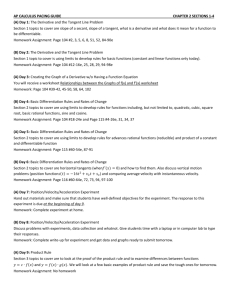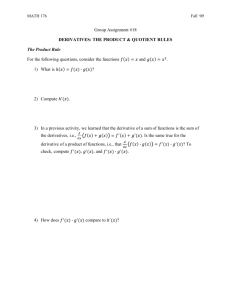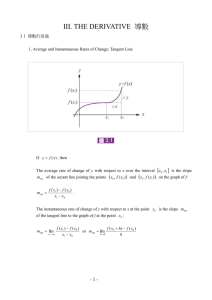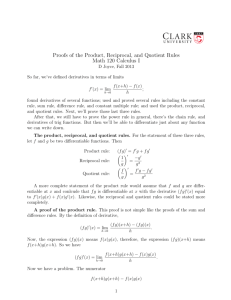1 Lecture 14: The product and quotient rule
advertisement
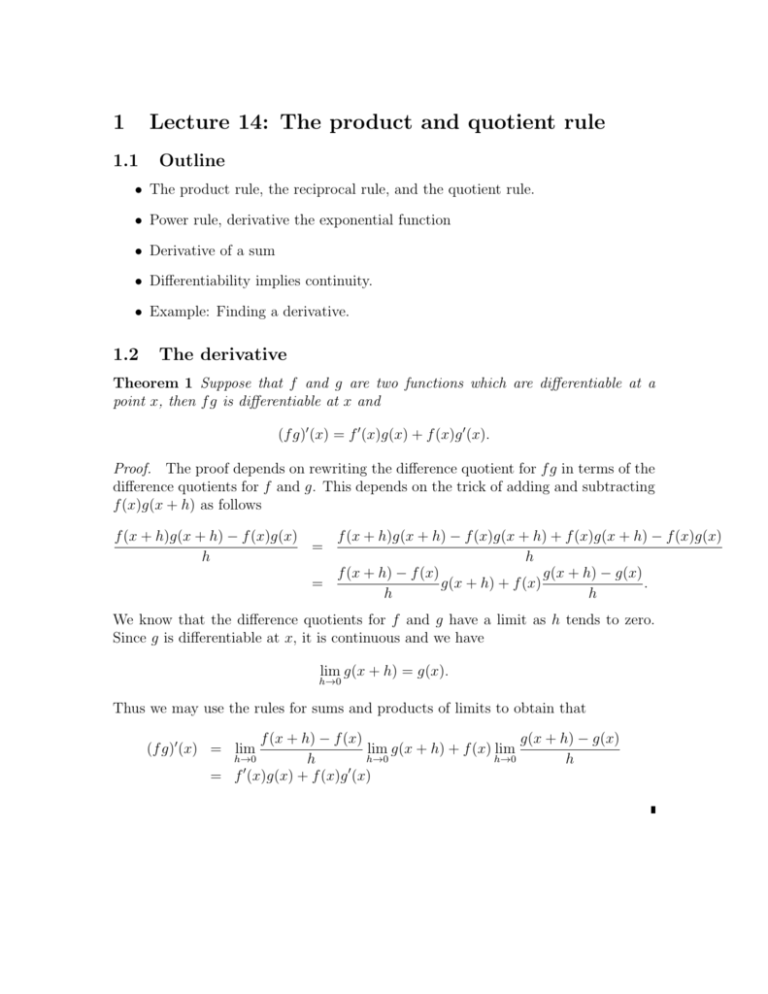
1 Lecture 14: The product and quotient rule 1.1 Outline • The product rule, the reciprocal rule, and the quotient rule. • Power rule, derivative the exponential function • Derivative of a sum • Differentiability implies continuity. • Example: Finding a derivative. 1.2 The derivative Theorem 1 Suppose that f and g are two functions which are differentiable at a point x, then f g is differentiable at x and (f g)0 (x) = f 0 (x)g(x) + f (x)g 0 (x). Proof. The proof depends on rewriting the difference quotient for f g in terms of the difference quotients for f and g. This depends on the trick of adding and subtracting f (x)g(x + h) as follows f (x + h)g(x + h) − f (x)g(x + h) + f (x)g(x + h) − f (x)g(x) f (x + h)g(x + h) − f (x)g(x) = h h f (x + h) − f (x) g(x + h) − g(x) = g(x + h) + f (x) . h h We know that the difference quotients for f and g have a limit as h tends to zero. Since g is differentiable at x, it is continuous and we have lim g(x + h) = g(x). h→0 Thus we may use the rules for sums and products of limits to obtain that f (x + h) − f (x) g(x + h) − g(x) lim g(x + h) + f (x) lim h→0 h→0 h h = f (x)g(x) + f (x)g 0 (x) (f g)0 (x) = lim h→0 0 One way to understand this rule is to think of a rectangle whose length ` and width w are given by `(t) = a + bt and w(t) = c + dt. Then the area will be given by `(t)w(t) = (`0 + mt)(w0 + nt) = `0 w0 + (mw0 + `0 n)t + mnt2 . At t = 0, the instantaneous rate of change of the area will be the coefficient of t, mw0 + `0 n. Since m is the rate of change of ` and n is the rate of change of w, the rate of change of the product is exactly what we see in the product rule. Example. Compute that derivative f (x) = x3 ex . Solution. We use the Leibniz notation, d 3 x d d (x e ) = ( x3 )ex + x3 ex dx dx dx = 3x2 ex + x3 ex . Example. Find the derivative of x6 by writing x6 = x3 · x3 and applying the product rule. Solution. We write x6 = x3 · x3 and apply the product rule, d 3 3 d d d 6 x = (x · x ) = x3 x3 + ( x3 )x3 . dx dx dx dx Computing the derivatives gives 3x2 · x3 + x3 · 3x2 = 6x5 . 1.3 Reciprocals We find the derivative of a reciprocal or the multiplicative inverse of a function. Theorem 2 If g is differentiable at x and g(x) 6= 0, then 1/g is differentiable at x and we have !0 1 −g 0 (x) (x) = . g g(x)2 Proof. We write out the difference quotient for 1/g, obtain a common denominator and simplify to express it in terms of the difference quotient for g, 1 1 1 1 g(x) g(x + h) ( − ) = − h g(x + h) g(x) h g(x)g(x + h) g(x)g(x + h) −1 1 = (g(x + h) − g(x)) . h g(x + h)g(x) Now we may use the limit laws and that 1/g is continuous at x to write 1 g !0 g(x + h) − g(x) 1 · lim h→0 h→0 g(x)g(x + h) h −g 0 (x) = . g(x)2 (x) = − lim Example. Use this rule to find the derivative d 1 . dx x4 Solution. d 1 dx x4 = −4x3 (x4 )2 = −4 . x5 We can use the reciprocal rule to extend the power rule to negative exponents. Example. Use the reciprocal rule to find the derivative d −n x , dx Solution. 1.4 d 1 dx xn = −nxn−1 x2n for n = 1, 2, 3, . . . . = −nx−n−1 . Quotient rule Finally we give the quotient rule. Note that it is often simpler to rewrite a quotient as a product and avoid the quotient rule. Theorem 3 If f and g are differentiable at x and g(x) 6= 0, then f /g is differentiable at x and !0 f f 0 (x)g(x) − f (x)g 0 (x) (x) = . g g(x)2 Proof. We may prove this writing f /g = f · g1 and using the product and the reciprocal rule. !0 f 1 1 −g 0 (x) (x) = (f )0 (x) = f 0 (x) + f (x) g g g(x) g(x)2 We may simplify this last expression by obtaining a common denominator. f 0 (x) −g 0 (x) g(x) −g 0 (x) f 0 (x)g(x) − f (x)g 0 (x) 1 0 + f (x) = f (x) + f (x) = . g(x) g(x)2 g(x)2 g(x)2 g(x)2 Example. Find the tangent line to f (x) = x2 − 1 x2 + 1 at x = 1. Solution. The tangent line will pass through the point (1, f (1)) = (1, 0). We need the derivative of f to compute the slope. We use the quotient rule to find the derivative of f , d d (x2 − 1))(x2 + 1) − (x2 − 1) dx (x2 + 1) ( dx (x2 + 1)2 2x(x2 + 1) − (x2 − 1)2x = (x2 + 1)2 4x . = (x2 + 1)2 f 0 (x) = At 1, we have f 0 (1) = 1. Thus the tangent line has the equation y − 0 = 1(x − 1). We simplify this to give y = x − 1 as the equation of the tangent line. September 25, 2012





